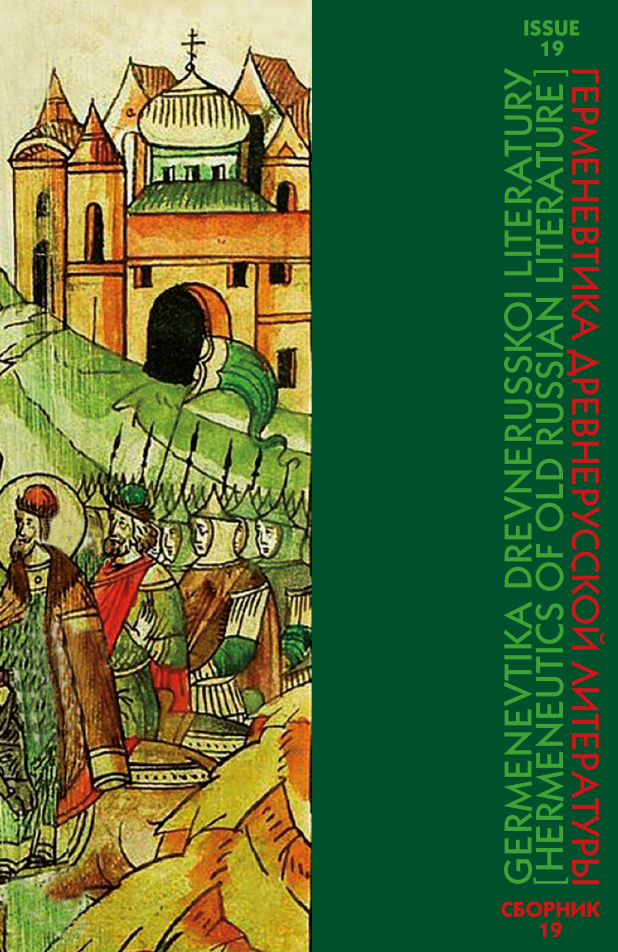Acknowledgements: The article was completed with the support of the Russian Science Foundation (grant no. 22-18-00005 “Iconography and hagiography of the Ladder of John the Sinai”).
Abstract:
The article examines the study of poetics of the short life (vita) of John of the Ladder, compiled by Daniel of Raifa. The text analysis is carried out on the material of the Russian translation of The Optina Pustyn Monastery. The life is an integral part of the creation of John the Sinai the Ladder. The author of article focuses on the topos of ladder, its semantic content, forms of expression and its function in the structure of the life (vita). The essential nexus of the life of the saint with his own creation determines the principle of comparison of the texts. The image of St. John of the Ladder is in the centre, as in the icon, organizing all the elements of poetics, including the topos of ladder. The ladder contains 30 steps (or “degrees”), which are reflected in the life (vita), but not in direct sequence, but in subordination to the law of iconicity and the basic principle of creating a hagiographic image — the reverse perspective. The main thing in the life (vita) is the space of Divine eternity, and for the hagiographer it is not the temporal progression of external or even internal events that is important, but hierarchy of virtues and its expression in the image of the saint whose example is to be followed. The panegyric nature of the life determines its metaphoricity, imagery, which allows the hagiographer to express briefly the main idea of the Ladder — ascent of the saint along the steps of virtues.
REFERENCES
1 Antonova, M.V. “Siuzhetnye toposy v agiografii. Postanovka voprosa” [“Plot Topos in Hagiography. To the Question Statement”]. Vestnik Brianskogo gosudarstvennogo universiteta, no. 2, 2013, pp. 172–175. (In Russian)
2 Gubareva, O.V. Ikona kak iskusstvo: Esteticheskie traditsii russkoi ikonopisi i sovremennaia vizual’naia kul’tura [Icon as Art: Aesthetic Traditions of Russian Icon Painting and Contemporary Visual Culture]. St. Petersburg, Argus SPb Publ., 2022. 356 p. (In Russian)
3 Dorofeeva, L.G. “Agiograficheskaia topika v zhitii Ioanna Sinaiskogo (na materiale staropechatnogo izdaniia Lestvitsy 1647 G.)” [“Hagiographic Topic in the Life (Vita) of John the Sinai (on the Material of the Old Printed Edition of the Ladder of 1647)”]. Novyi filologicheskii vestnik, no. 3(62), 2022, pp. 106–124. (In Russian)
4 Kliuchevskii, V.O. Kurs russkoi istorii [A Course Book in Russian History], part. 1, 3rd ed. Moscow, Petrograd, Gosudarstvennoe izdatel’stvo Publ., 1923. (In Russian)
5 Lepakhin, V.V. “Ikona i obraz” [“Icon and Image”]. Ikona v russkoi slovesnosti i kul’ture [Icon in Russian Literature and Culture], comp. and ed. V.V. Lepakhin. Moscow, Palomnik Publ., 2012, pp. 1–71. (In Russian)
6 Lepakhin, V.V. “Lestvitsa kak polifonichnyi simvol dukhovnoi asketicheskoi zhizni” [“The Ladder as a Polyphonic Symbol of Spiritual Ascetic Life”]. Vestnik russkogo khristianskogo dvizheniia, no. 178. Paris, 1998, pp. 5–28. (In Russian)
7 Loparev, Khr. M. Grecheskie zhitiia sviatykh VIII i IX vekov : Opyt nauch. klassifikatsii pamiatnikov agiografii s obzorom ikh s tochki zreniia ist. i ist.-lit. (Dis.) [Greek Lives of the Saints of the 8th and 9th Centuries: a Scientific Classification of Monuments of Hagiography with a Historical and Literary Review (Thesis)], part 1. Petrograd, Academy of Sciences Publ., 1914. Available at: https://azbyka.ru/otechnik/Hrisanf_Loparev/grecheskie-zhitija-svjatyh-8-i-9-vekov/1 Accessed 27 June 2023) (In Russian)
8 Losskii, V.N. Ocherk misticheskogo bogosloviia. Dogmaticheskoe bogoslovie [Mystical Theology of the Eastern Church. Dogmatic Theology]. Moscow, Tsentr “SEI” Publ., 1991. 288 p. (In Russian)
9 Popova, T.G. “K istorii slavianskikh perevodov terminov πρωτεῖα i πρεσβεῖα (na materiale Lestvitsy Ioanna Sinaiskogo)” [“On the History of Slavic Translations of the Terms πρωτεῖα and πρεσβεῖα (Based on the Material of the Ladder of John the Sinai)”]. Ermilov, P.V., and M.V., Gratsianskii, editors. Poniatie pervenstva: istoki i konteksty. Kollektivnaia monografiia [Concept of Primacy: Origins and Contexts. A Collective Study]. Moscow, St. Tikhon’s Orthodox University Publ., 2022, pp. 153–178. (In Russian)






